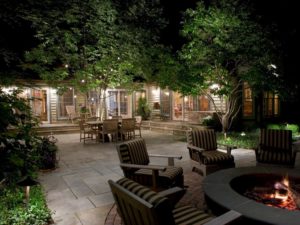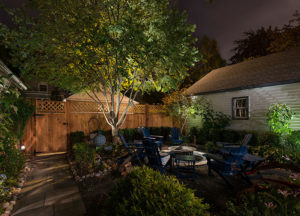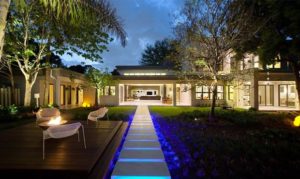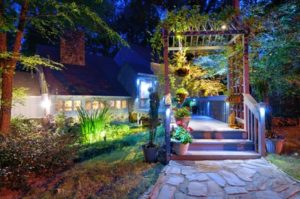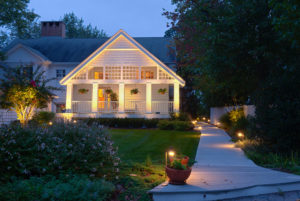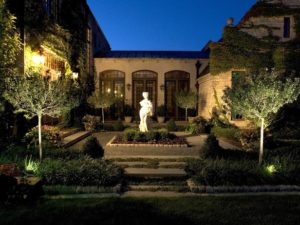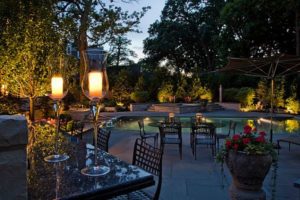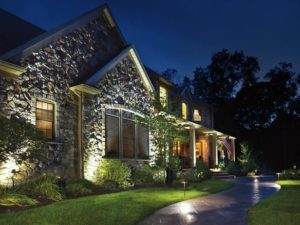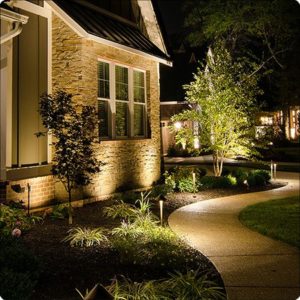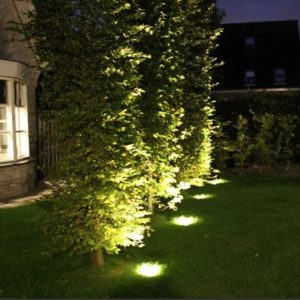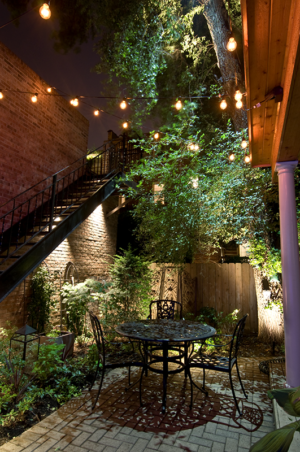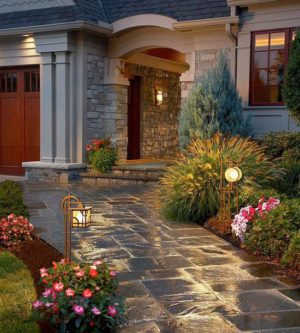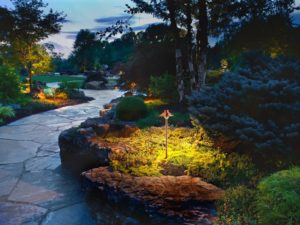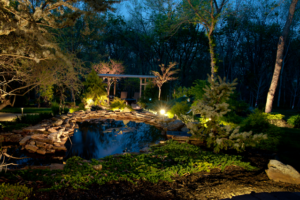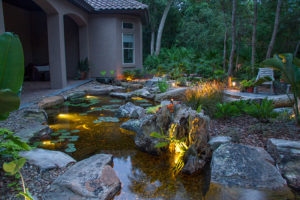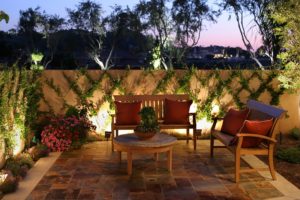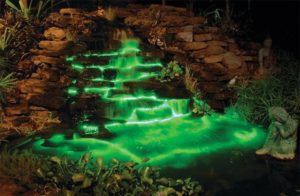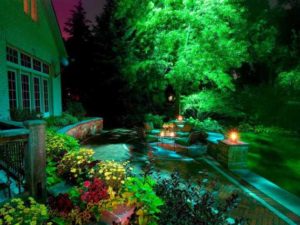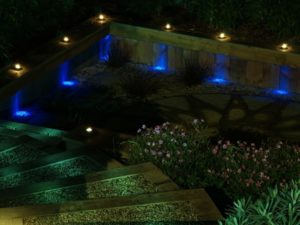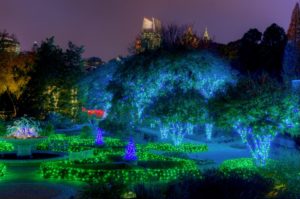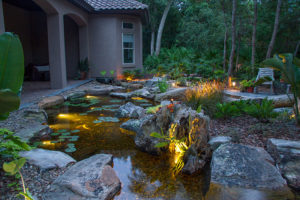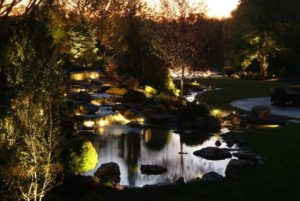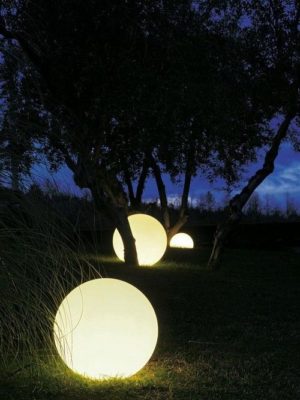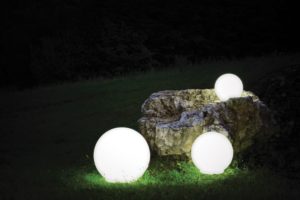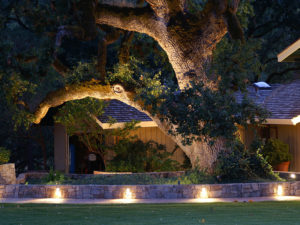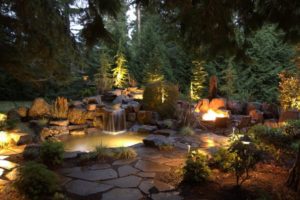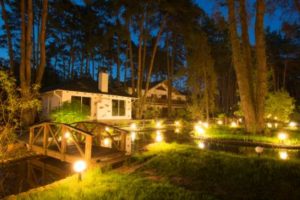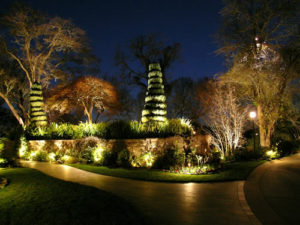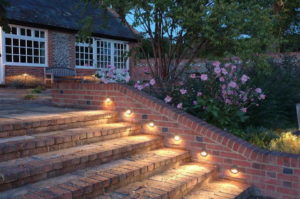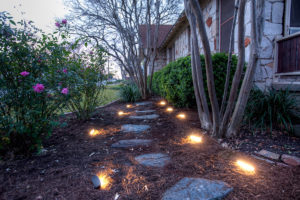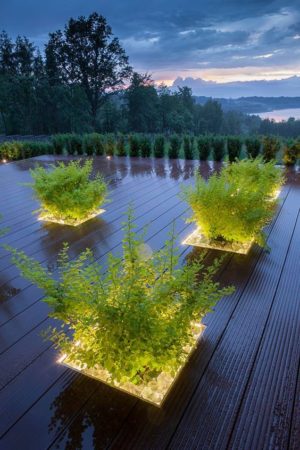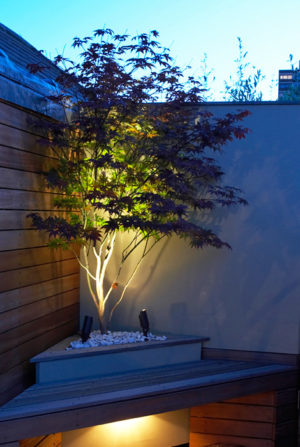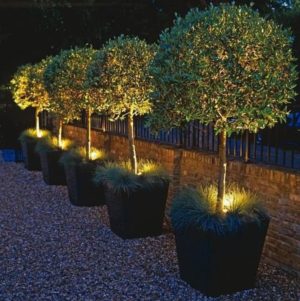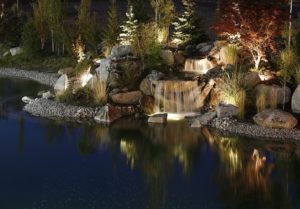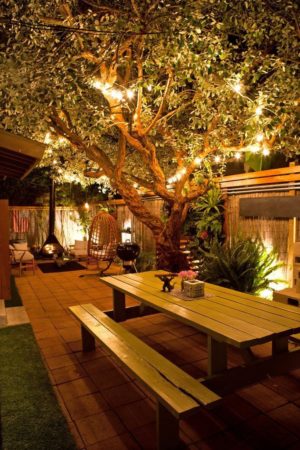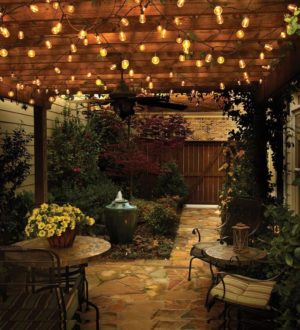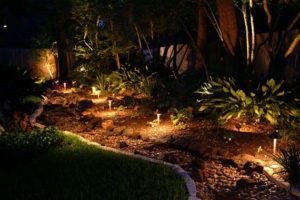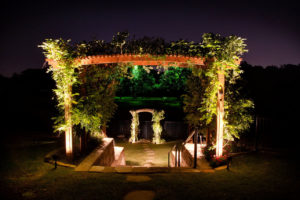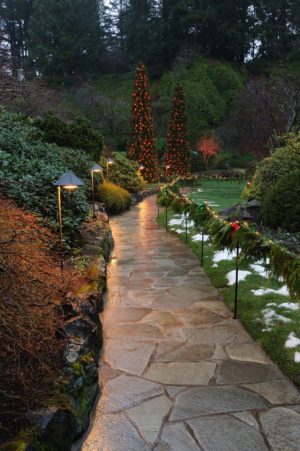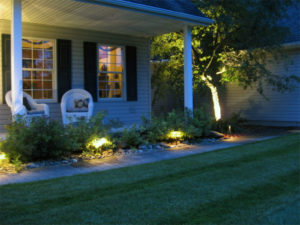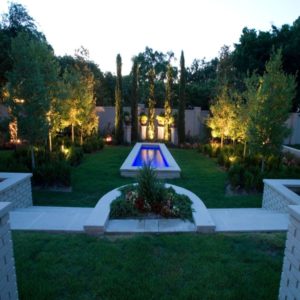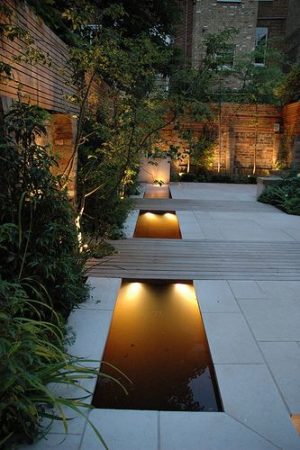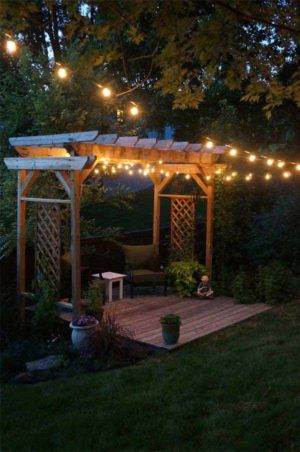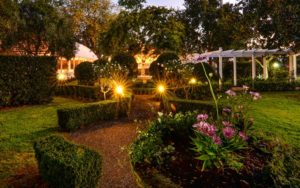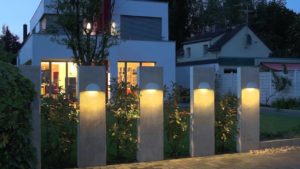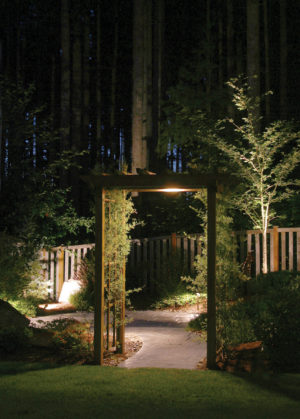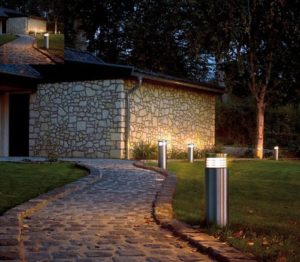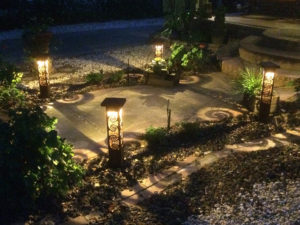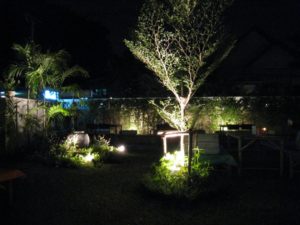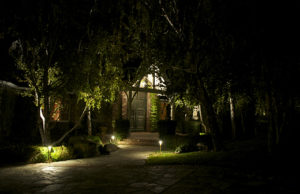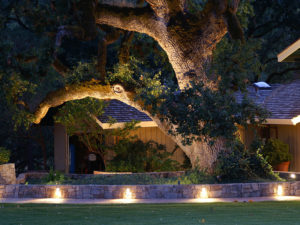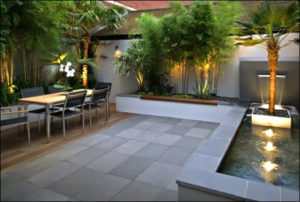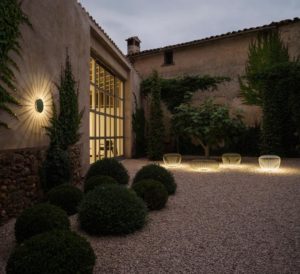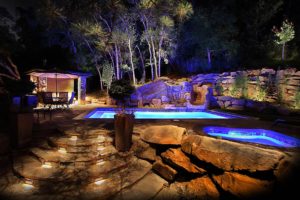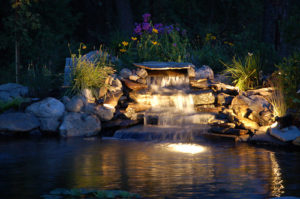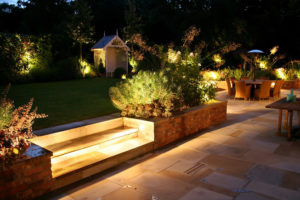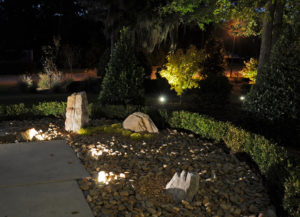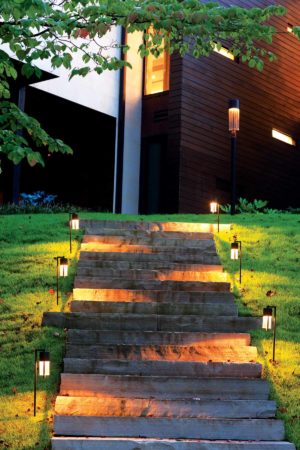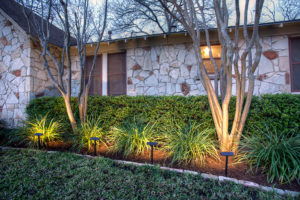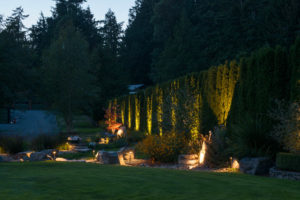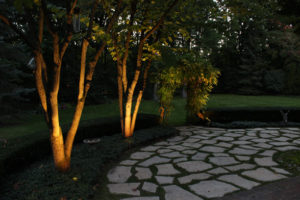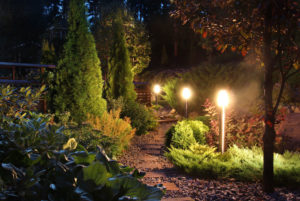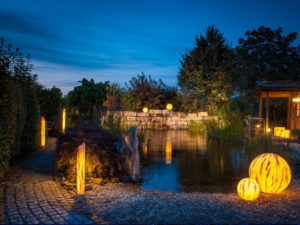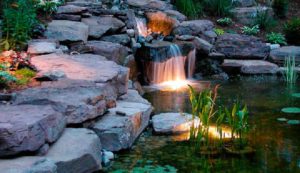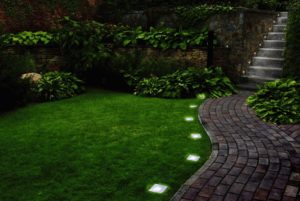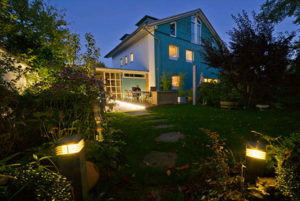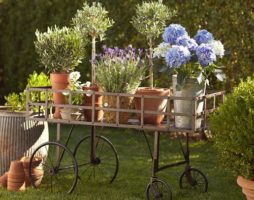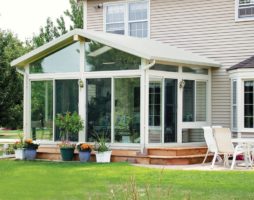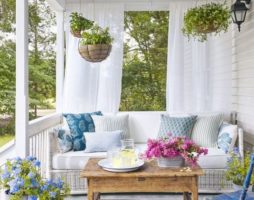A country house, in addition to being a place of permanent or seasonal residence, also provides an excellent opportunity for self-realization. And the easiest way to do this is by devoting yourself to beautifying the surrounding landscape.
- How lighting is created in landscape design
- Landscape details that need highlighting
- Types of Landscape Lighting
- Ways to illuminate the landscape
- The nuances of landscape lighting plants
- Decorative lighting of flower plantings
- Choosing lamps for landscape lighting
- Conclusion
- Photo Gallery - Landscape Lighting
- Video
The work will consist not only in planting plants and laying out flower beds, but also giving the garden a special charm. If flowers and decorative elements are responsible for this atmosphere during the day, then in the evening it will become the responsibility of landscape lighting. This is a fairly large area of work in the design of a personal plot. Arrangement of lighting has its own subtleties and requires a serious approach to the implementation of ideas.
How lighting is created in landscape design
High-quality garden lighting can only be provided by a multi-level system of correctly grouped correctly directed lighting elements. They will have to simultaneously perform both the main functional task of illuminating the territory and decorating its space with their glow.
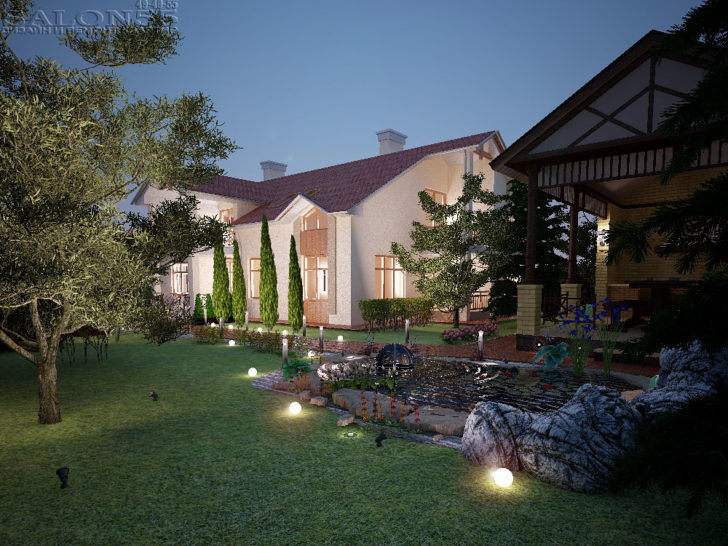
Landscape lighting performs not only a functional role, but also a decorative one.
The arrangement of lighting elements, as a rule, is drawn up at the final stage of landscape design development. Lamps representing landscape lighting should focus on the most successful views from the windows, designate private areas and represent front doors. Then they determine with the adequacy of the placement points of the illuminating structures and preliminarily estimate how powerful the lamps should be in them. This will also allow you to determine:
- with the number and type of landscape lighting fixtures that will need to be purchased;
- the color scheme of their shades;
- direction of light supply.
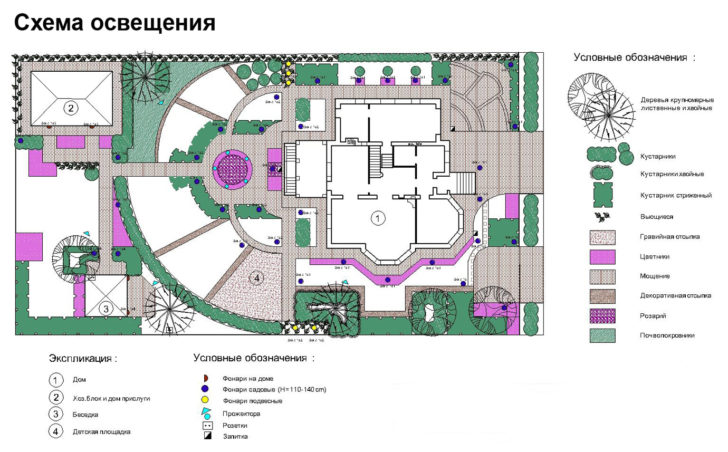
An example of a landscape lighting scheme
Landscape details that need highlighting
All obstacles on the site, whether natural or artificially created, are subject to mandatory highlighting. First of all, lighting of reservoirs in landscape design is being arranged. Here a special approach is needed. If you make a perimetric backlight, then even a puddle will seem prohibitively deep, almost a dark pool. But the location of light sources at the bottom or directly on the surface of a water body will produce the exact opposite effect, and instead of a black frightening abyss, a mysterious pond will appear on the site, for example.

Bottom illumination of the reservoir
It is good to hide lamps that create decorative landscape lighting in the crowns of plants. Bushes and trees acquire volumes, and the site is replenished with a luminous ornate object.
Alpine Hill is a great place for a turn of fantasy.The illumination of such an element in landscape design can be performed either by a single floor lamp, mounted on top, or by several flat lamps, laid at the base. Any decision, of course, will enrich the composition and favorably present its most successful elements.

Lighting an alpine slide with a single lantern
You can resort to a non-standard option for landscape lighting and put a garland on an alpine hill with a luminous serpentine. If there is no need to emphasize any details of the object, it is better to move the lamps away from it. In this case, such representatives of landscape lighting as directional lights will be good. The rock garden surrounded by them will look natural.
Flowerbeds and flower beds can be illuminated in a non-standard way by using an old wide glass vase as a lamp. Light bulbs powered by solar energy are placed inside the container. The vase is placed in the center of the flower bed, turned upside down and slightly dug. The soft light of solar lamps will be enough to highlight the beauty of flowering plants.
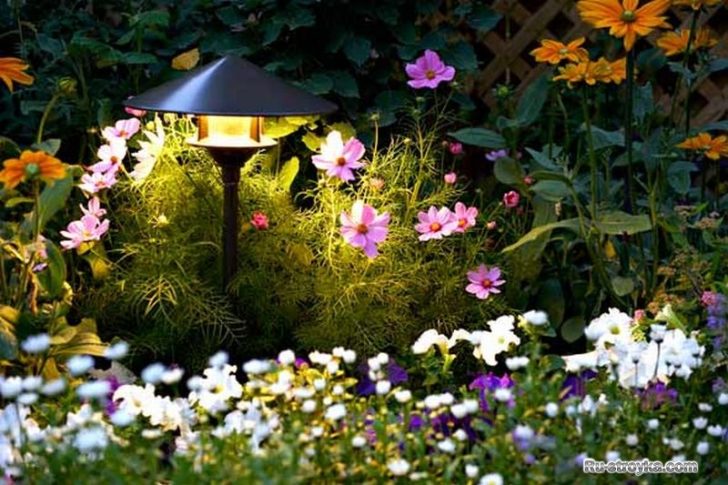
Lantern highlights the beauty of flowering plants
But the paths are highlighted not only for decorative purposes. The safety aspect is also relevant here, so it will be necessary to carry out an adequate selection of luminaire designs. They must comply with the architectural design of the alleys.
back to index ↑Types of Landscape Lighting
Before starting to deal with the variety of ways to organize lighting in landscape design, it should be noted that the backlight can be represented as:
- general;
- accent.
By correctly balancing the flooding general light and accent lighting, you can achieve high artistry of the area being decorated.
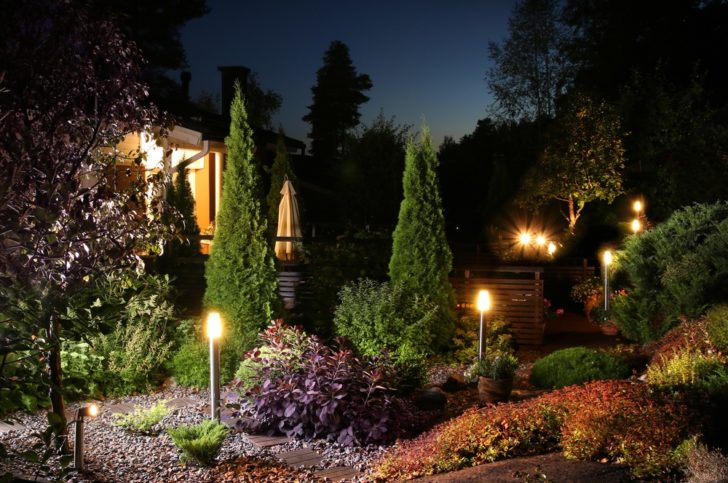
General landscape lighting
When creating a lighting design project, you need to highlight the main objects and background elements of the overall picture, designate focal points, and then form smooth transitions between all this.
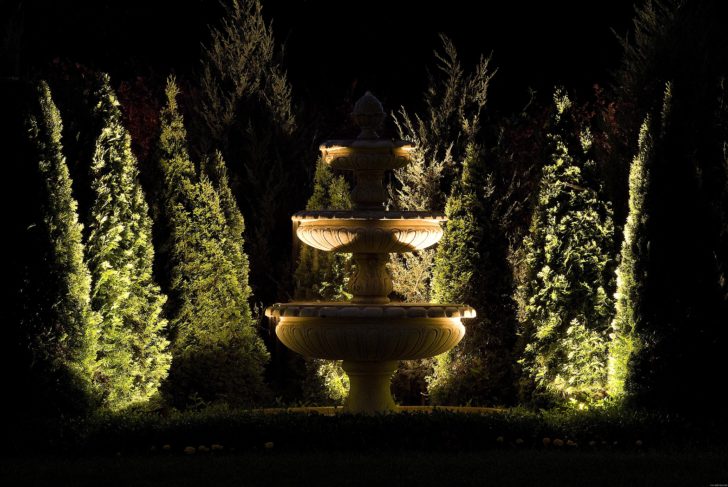
An example of accent lighting
Ways to illuminate the landscape
To make the backyard territory in the evening hours no less attractive than during the day, you need to correctly illuminate it. In fact, the development of a lighting project is a set of certain techniques. This is a combination of multi-level landscape lighting schemes and fixtures.
So, on the site should be:
1. General lighting.
2. Highlighting flora.
3. Architectural lighting.
4. Illumination of reservoirs.
General lighting
Its task is to emphasize the layout of the territory, to show the location of the main objects, access roads, sites, gazebos, buildings, etc. Landscape lighting here is provided by lamps of the type:
- lanterns;
- searchlights;
- decorative supports;
- hanging lamps;
- bollards.

Floodlights provide general lighting
Highlight flora
In any landscape there are green spaces, which can be distinguished by a directed stream of light. This is a great way to turn flower beds, rockeries, rock gardens, trees and bushes into art objects. With skillful landscape lighting, they will sparkle with new colors. What height, power, type of light supply to choose lamps will depend on the size and shape of the plant, the texture of their trunks, the light-absorbing capabilities of the leaves and their seasonal variability.
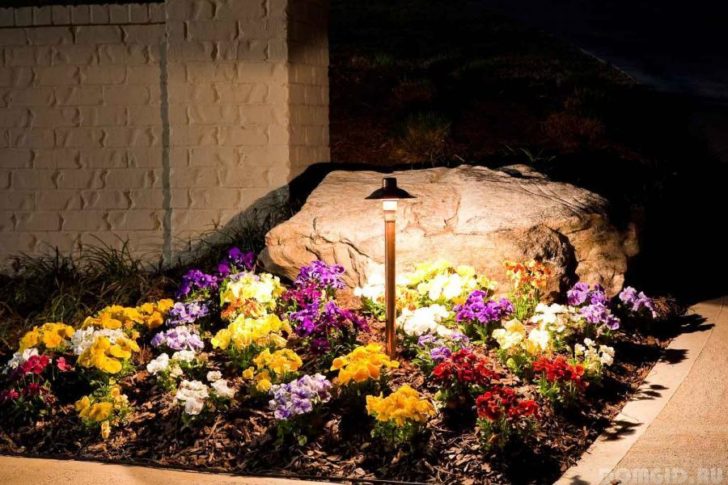
Illumination of flowers will allow the landscape to sparkle with new colors
architectural lighting
“When designing architectural lighting in landscape design, they must take into account the shape, proportions and design of the house, the features of the transition of one architectural form to another, the color scheme of the facade decoration”
This is a way of lighting in landscape design designed to emphasize the beauty of the architecture of buildings. The emphasis is on individual fragments of houses, the texture of the walls, the originality of the roofs.Preference is given to elegant, well-designed lighting structures that are installed on the peaks of buildings, their walls or dug into the ground. For greater efficiency, you can try combinations of highlights.

Architectural lighting enhances the beauty of buildings
Illumination of the building allows the house to remain attractive even in the evening hours. When designing architectural lighting in landscape design, one must take into account the shape, proportions and design of the house, the features of the transition of one architectural form to another, the color scheme of the facade. This will help determine the installation points of the fixtures and the angle of their supply of light streams. The task is difficult, so it makes sense to resort to the services of professionals. They have knowledge of the latest landscape lighting technologies and practical skills that will allow you to realize any fantasies regarding the arrangement of the night garden.
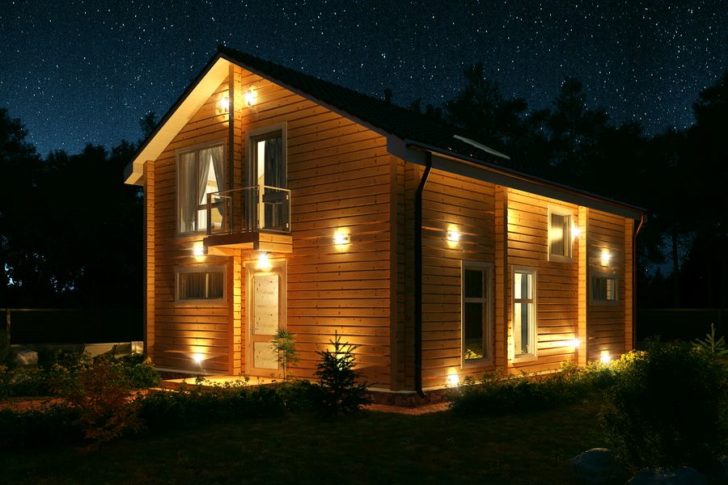
When installing lighting, it is necessary to take into account the proportions and design of the house.
Artistic lighting of objects, in addition to a professional approach, also requires specific lighting equipment. In landscape lighting, modern lamps will allow you to reproduce entire light patterns on the walls of buildings, create dynamic lighting and original follow-up lighting. Here you will need to play with the intensity and color spectrum of the outgoing rays, as well as the direction of their supply.

Decorative landscape lights
Designers use three main home lighting schemes.
Flood lighting
Its task is to illuminate the entire building. Reception is relevant for lighting large-scale buildings, as a rule, non-residential type. The object is snatched out of the darkness by powerful landscape lighting fixtures: spotlights installed on the ground or nearby buildings, and street lamps. In their rays, the shape of the object and all the original details of its decoration are clearly visible. The presence of flood lighting is mandatory in the landscape design of church territories, palaces of cultures, museums, as well as in places where life is in full swing at night.

Flood lighting at home
Local illumination
Its rays illuminate only the most expressive areas of the facade decoration and emphasize the structural features of the building. This is a great way to highlight balconies, balustrades, cornices, friezes. To ensure the effect, groups of spotlights are used that give a directional light flux. They are installed directly on the facade of the illuminated object.
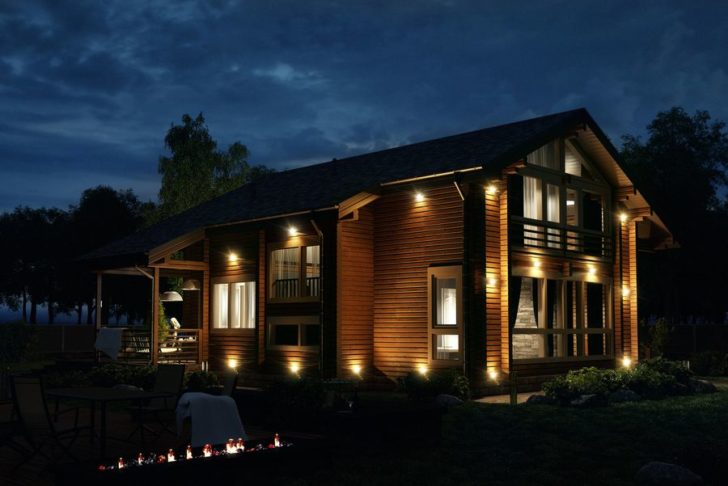
Local illumination of the house
Hidden backlight
A relatively new trend in landscape lighting. The task of the lamps is not to illuminate the walls, but to create a unique light pattern on them. In this case, it will be possible not only to follow the architectural reliefs of the building, but also to create arbitrary decorative compositions.
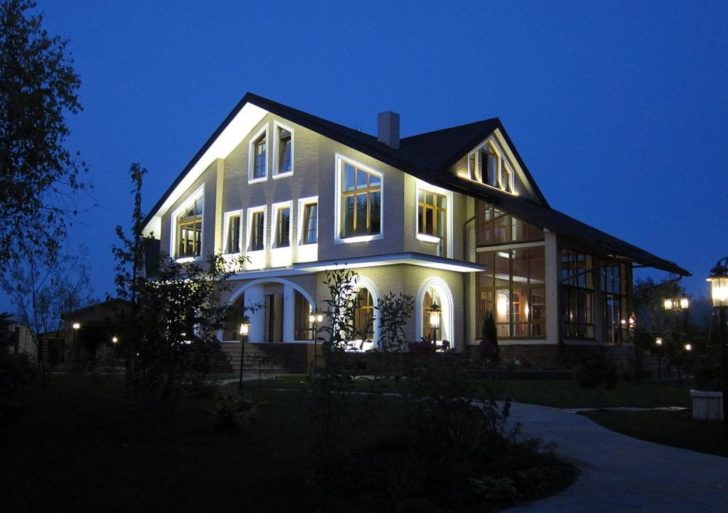
Hidden backlight creates a unique light pattern
Illumination of reservoirs
Illuminated water bodies will certainly become an accent zone of any territory. With the right approach to choosing lamps for this type of landscape lighting, streams, waterfalls, ponds, lakes, pools and fountains will look like real works of art.

Illumination of the reservoir
The nuances of landscape lighting plants
A variety of light sources are used to emphasize the unusual forms of plants and the saturation of the color of their foliage. Their design is selected in accordance with the tasks and with an eye to the current season. Despite some disadvantages, it is still recommended to use unsightly, by today's standards, incandescent lamps in the illumination of vegetation. A spotlight with mercury light carriers is also suitable. They will give the leaves a pleasant turquoise hue.
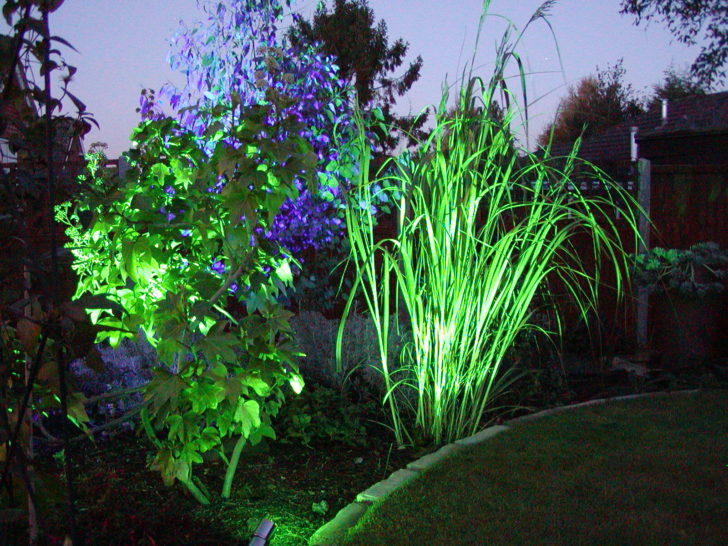
Mercury lamps will give plants a turquoise hue
To create interesting color effects, the property of lamps will help to give a certain color spectrum of light inherent only to them. Try lighting flower beds in landscape design with fluorescent lamps, trees with mercury lamps, shrubs with Ilyich lamps, and see what a magnificent sight will appear before your eyes. You can illuminate bushes and trees by installing lamps on the ground, somewhere on the trunk or under the very crown. The second and third options are relevant for single landings. The inner glow emphasizes the beauty of the crown shape and makes the object clearly visible against the background of a dark array of planting or sky. Illumination from below and behind makes the contours of the plant clearly visible.

Inner glow highlights the beauty of the crown shape
Incandescent lamps are recommended for use in landscape lighting for floodlights, not only in the spring-summer season. They remain relevant in the autumn, when the foliage changes color, becoming purple-yellow. But in winter, snow-covered branches will look better in the rays of colored light streams. They will create a festive mood in the garden. Bare branches will look good highlighted by landscape lighting pouring from the background, that is, from behind them. The beam of light itself will become a kind of background, and the bare trees will stand out on it with sophisticated dark silhouettes. A special approach is recommended for lighting in the landscape design of birches. Their whitish trunks are magnificent in the rays of searchlights set on the ground.
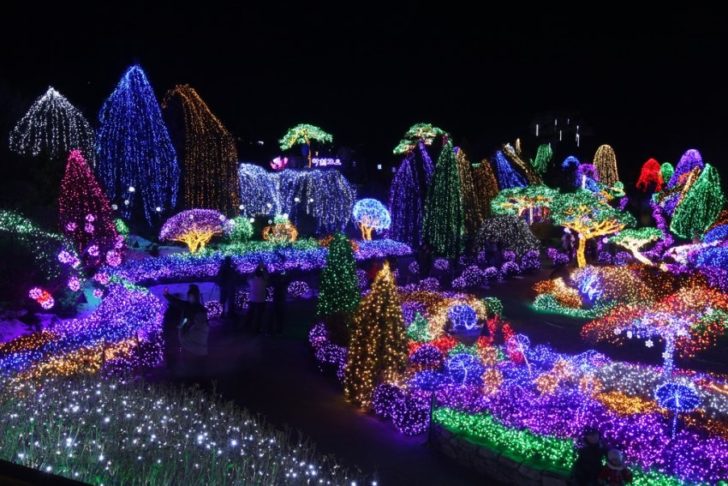
Colored lighting will create a festive mood in the garden
In terms of park decor, it is important to make the right choice of objects to be illuminated. Here you need to put on display architectural dominants, entrance groups, platforms, the most attractive landings and leave everything ordinary in the shade. Here, the game of contrasts will come to the fore in the coverage of landscape design, since it is she who is responsible for the volumetric visual perception of the presented composition. A certain contribution to this will be made by light strips and neon inscriptions available in the design of arches and attractions.
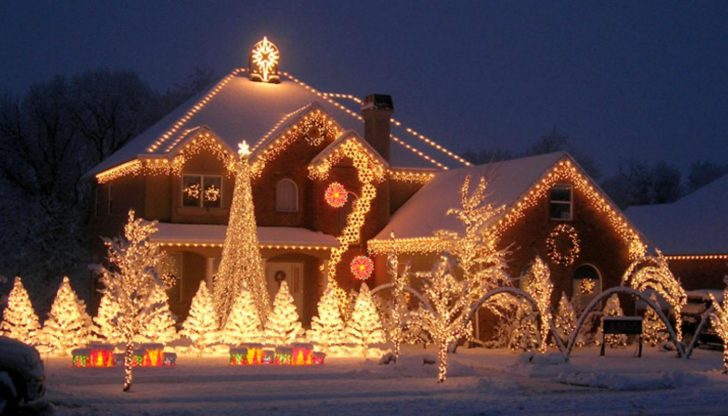
Highlighting architectural dominants will add depth to the landscape
It is more correct to highlight volumetric structures, decorative sculptural compositions, obelisks and monuments in landscape lighting with directional light sources. Usually, spotlights standing on low stands, hidden in concrete niches or recessed into the ground are used. In the same way, tall trees growing surrounded by dense shrubs can be accentuated. The latter will mask the source of light emission from the eyes of observers. Special requirements are imposed in landscape lighting on interior lamps used in the electrification of premises. They will double duty. On the one hand, they should illuminate the interiors with high quality, on the other hand, they should form the external appearance of the perception of an architectural object.
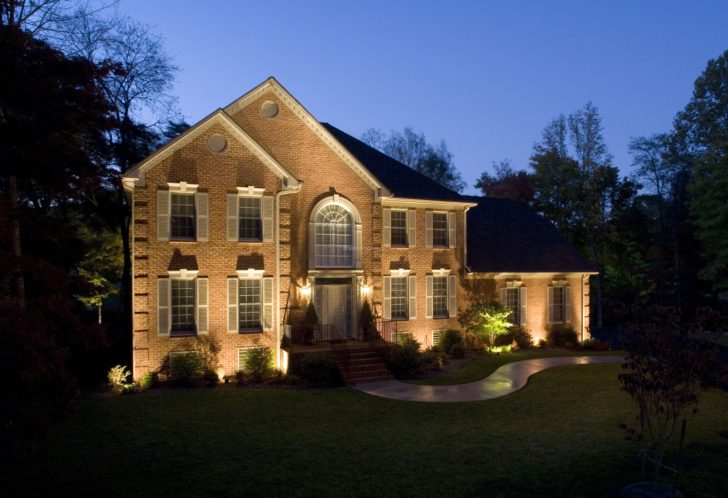
Illumination of the facade of the house with hidden lamps
Gliding beams can be used to enhance beautiful buildings.
In modern parks, glass pavilions often become luminous objects. These lamps, which are quite large for landscape lighting, are perceived as effectively as possible if they are located near water bodies. The reflective ability of the water surface stimulates the play of colors, adds brightness and brilliance to them with water reflections.
A very interesting solution to lighting problems in park landscape design was found in Munich. There, on an area of 70 hectares, a cable-stayed coating was used, assembled from steel cables and a transparent film, which was stretched over the main structures. The grandiosity of the luminous coating did not make it difficult to perceive. On the contrary, it favorably emphasized the spatial solution of the landscape of the park area as a whole and determined its architectural features.

Lighting in a park in Munich
To get the most aesthetic value out of plant lighting, you need to understand what to focus on when planning landscape lighting. First of all, the texture of the trunk, the method of branching, the shape of the leaf, the intensity of the density of the crown, its seasonal color, growth rate, the type of inflorescences and the color of the flower petals are important. All these nuances directly affect the choice of the type of landscape lighting.
In trees with a dense impenetrable crown, illumination is provided by distant light sources. Thus, flood lighting of the tree from the outside is organized. With a transparent crown, lamps can be placed directly on the trunk and direct their light so that it penetrates between the leaves. Illumination of tall trees in landscape design, especially pyramidal forms, occurs with spotlights, the design of which provides for concentrating optics. They are placed no closer than 5 or even 10 meters. In the illumination of palm trees, it is also recommended to use spotlights. Spots will highlight the crown, and spotlights will get the role of emphasizing the texture of the trunk.

Illumination of tall trees with a dense crown is carried out by spotlights
Dense, rounded crowns, such as those of magnolia, can also be illuminated with distant light. If you need to provide circular illumination, then you should take care of the correct angle of light supply. It should not hit the eyes and give a blinding effect. There will be no restrictions on the angle of aiming lighting in landscape design if the lighting fixtures can be placed in the shielding zone, that is, in bushes or other undersized plantings. However, this must be done so that bright highlights do not appear on their leaves.

Circular tree lighting
Problems with the arrangement and selection of types of lamps arise most often in young gardens, since here you will often have to adjust landscape lighting, that is, retarget devices, and sometimes even transfer them. The way out of the situation can sometimes be the purchase of lighting structures with height adjustment.
In too tall conifers, it is sometimes difficult to highlight the entire crown. Experts say that in this case, you can limit yourself to its lower backlight. The effect will be no less impressive.

Coniferous plants are usually illuminated from below.
It is no less difficult to organize landscape lighting with lamps spreading oak crown. Since it is extremely voluminous, it is necessary to expand the number and diversify the quality of lamps in its illumination.
A serious problem for lighting in landscape design is the growth of plantings. This, by the way, is the main reason why there is a need for seasonal maintenance. Luminaires are cleaned, reinstalled, repurposed. In order for the system to work as fruitfully as possible, sometimes it is even necessary to remove some plants that interfere with its functioning. You need to know about this in order to lay a supply of cable during the initial arrangement. This will greatly simplify the operation of the system in the future and will not become an obstacle to the transfer of lighting devices.

As the garden grows, the lamps are reinstalled
For the same reason, recessed landscape lighting fixtures are not recommended for growing gardens. Uplights are suitable only for mature plantings. Juveniles are predominantly illuminated by low-voltage devices mounted on adjustable support pins. Their work is easier to correct. The fact that the lighting of trees in landscape design is often done from below is due to the ease of installation of spotlights, however, the top illumination gives a more natural perception of the plant. It is well recognizable because it looks the same as during the day. With lower-tier illumination, the play of chiaroscuro creates a slightly different effect. Shadow and light seem to be reversed here.
Overhead light is a less contrasting solution. Since a sufficiently large surface of the soil is illuminated, there is a greater consistency of objects, which is reflected in an improvement in the emotional perception of the composition. A person can distinguish details, consider the color of foliage. The main obstacle in the organization of the upper type of lighting in landscape design is the lack of supports for the installation of lighting elements. If there are no suitable buildings, neighboring trees can be involved in the case. Lamps on the trunks and crowns will open combinational horizons, which will untie the hands of designers.

You can install lamps directly on trees
Unusual effects are given by side illumination of especially specific trees or original group plantings. They become a magnificent sight against the background of the darkness of the rest of the green massif.

Spectacular side lighting of trees
There are a few more subtleties of landscape tree lighting. It is more expedient to highlight small individuals completely, flooding them with uniform light. On the crowns of tall and spreading trees, it is more correct to make a series of picturesque light spots that attract with brightness. The best landscape lighting will be provided by luminaires with high power incandescent lamps of 300 or even 500 watts. From mercury lamps, you should choose models with a power of 250 watts. At least three spotlights will need to be directed at each 8-12-meter tree.
back to index ↑Decorative lighting of flower plantings
For lawns and flower beds, floodlights will be the leading type of landscape lighting. Here it will be important not so much the power capabilities as the spectral composition of the radiation source. Moreover, these indicators will need to be correlated with the color scheme of the flower bed. So, to enhance the color of flower petals, lamps of the same tone are used in landscape lighting. It is known that mercury lamps make blue-blue shades brighter, and sodium lamps brighten any representatives of the red spectrum.
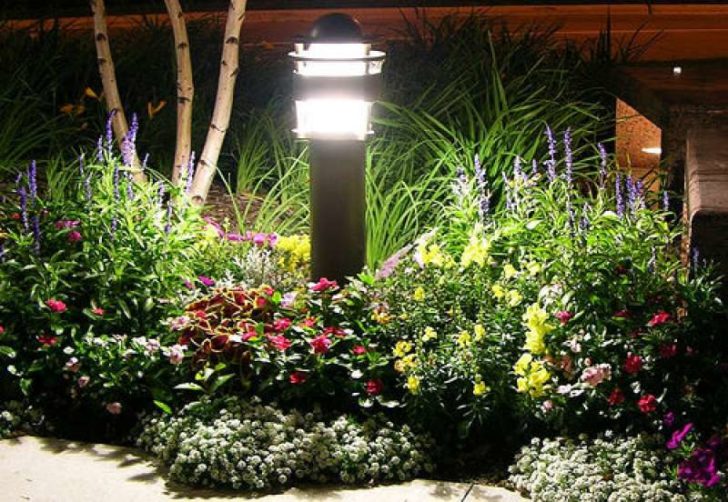
Illumination of flower beds with flood light
Lighting fixtures should be arranged so that the usual color shade of plants is provided. General lighting for flower beds and lawns in landscape design is provided by floor lamps, the so-called "bells", "mushrooms" and "umbrellas" from a height of one and a half meters, equipped with incandescent lamps up to 150 watts.
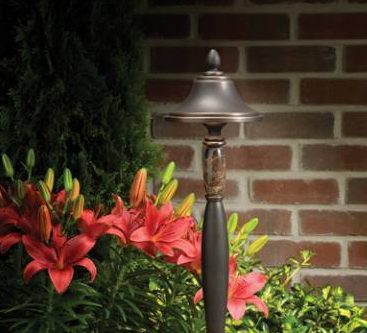
Illumination of the flower bed with a floor lamp
Choosing lamps for landscape lighting
“The luminaires used in landscape lighting should be attractive and proportionate to the space being designed”
What is important in this matter? First of all, structural features. For example, small architectural forms require delicate, very soft lighting, which will never be given by powerful spotlights that are appropriate in drawing tall trees.

Very soft lighting suitable for buildings
A special approach is also needed for the lighting design of the tracks. The principle of direct proportionality applies here. The wider the alley, the more powerful lighting it will need. Failure to follow the recommendations and inadequate selection of lamps will lead to the fact that the light they supply will either blind or leave shaded areas. In both options, moving along the paths will be uncomfortable and dangerous. In landscape design, it is customary to highlight garden paths with columnar lamps of the appropriate height situation.

Paths need more powerful lighting
Luminaires used in landscape lighting should be attractive and proportionate to the space being designed. Their task is to look harmoniously on the site and in the daytime, becoming for this period small decorative forms for the landscape.For this, the supports of the structures must be the product of lightness and grace, only in this way they can be painlessly entered into the natural landscape.

All fixtures should harmoniously fit into the landscape.
Conclusion
There are many options for organizing lighting in landscape design. The leading criteria for choosing his scheme are financial capabilities and the vision of the object by the customer. The right decision is the key to the comfort of staying in the landscape gardening area at night and its round-the-clock decorativeness. Entrust the arrangement of the landscape to a specialist and believe me, the result will be worth the effort spent!
back to index ↑Photo Gallery - Landscape Lighting
Video
